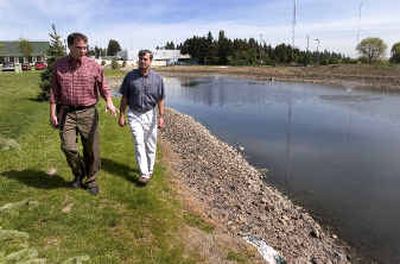Handling a rocky situation

Under current city regulations, Greenstone Corp.’s new 40-acre housing development on the South Hill would have required a six- to seven-acre storm-water evaporation pond, and that was simply unacceptable to company President Jason Wheaton.
“Every evaporation pond built is an opportunity lost. It is unsightly, it smells and it is a health hazard,” Wheaton said of the large ponds adjoining many Moran Prairie businesses near Greenstone’s Adirondack Village. The development at 44th and Regal includes 228 apartments and 69 single-family home sites.
Instead, Wheaton and Greenstone’s in-house civil engineer Doug Desmond worked for eight months with city officials to come up with a solution that met local requirements and was aesthetically pleasing. The result has Spokane city and county officials taking note as they search for regional storm-water solutions. Planning Commission members, county staff and scientists recently toured Adirondack Village and were impressed, said Brenda Sims, the county’s storm water utility manager.
“I’d certainly like us to explore some ideas like that,” Sims said.
Increased flooding in some areas over the years has led to the adoption of laws requiring that new development not put additional water into the ground or cause more runoff. Grassy swales frequently don’t work in the Moran Prairie area because the rocky ground prevents water from being absorbed.
For many developers, that left few choices but lined evaporation ponds, which capture storm water in shallow basins. But the ponds brought their own problems. Spokane County’s ponds on 57th Avenue have posted notices warning of chemicals sprayed to control mosquitoes from May to September. The ponds require up to a third of the land in a development site, Wheaton said, and owners have to clean them of the weeds and algae that grow in the stagnant water.
Adirondack Village’s system instead has one 4½-foot deep, ¾-acre pond with an irrigation system that pipes water out and sprays it onto nearby lawns in the apartment complex. Additional “surge ponds” scattered throughout the development make up the square footage needed to contain the storm water resulting from a large rainstorm.
The large pond has fountains spraying water in the middle and a waterfall feature at one end. It’s surrounded by a grassy area and trees. On Tuesday afternoon, a woman and young girl played in the grass next to the basin.
“It’s definitely innovative and fairly new,” said Tom Arnold, director of engineering services for the city. “You can turn storm water into an asset rather than a detriment to your development. We’re getting more and more ideas like that because land is money, and you’re taking up all the land with huge storm-water facilities.”
Wheaton said the region’s storm-water problem is “the leading development problem taking place right now.” Though he expressed appreciation to the city for helping develop Adirondack Village’s system, he said city and county officials are not moving fast enough to develop a regional storm-water system. He said the money spent developing the huge evaporation ponds should have been spent contributing to a new regional system instead.
Arnold said he understands the developers’ concerns, but said the cost of a regional system would be huge and in the interim, storm water must be controlled.
“Obviously if we had a regional system in place, we could offer another tool for a developer” and not use up all the land containing storm water, Arnold said. “It’s quite a dilemma for all of us, and it’s definitely an impact to developers.”